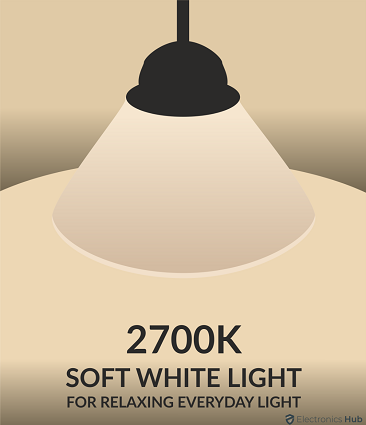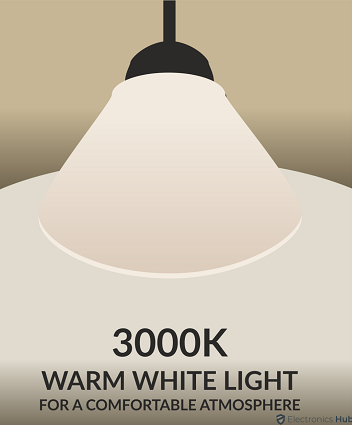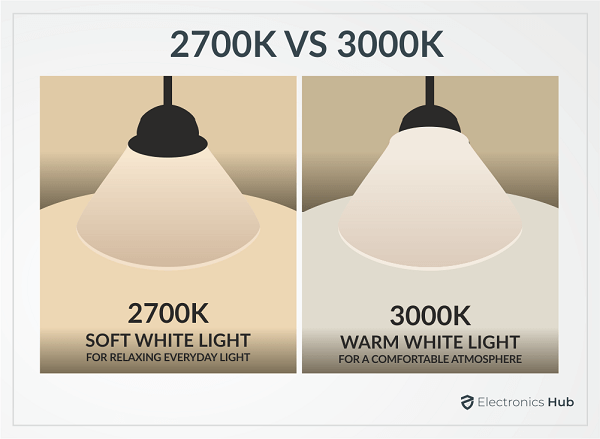Firstly, you need to get a clear idea about what colour temperature is. Colour temperature is the measurement to describe the light emitted by any lamp concerning how warm or cool it looks. So, it is the way to describe the relative warmness or coolness of the different colours of white light. The unit of colour temperature is Kelvin. It varies from 1,000 to 10,000. The higher Kelvin rating indicates brighter light emitted by the source. Now, we will go into detail about the 2700K and 3000K white light.
About 2700K
To understand the meaning of 2700K white light, we need to consider an incandescent lamp. The filament featured in the lamp when hot, emits light. Now, if the filament achieves a temperature of 2700 degrees Kelvin when it emits the brightest light possible, then the light bulb is said to be of the colour temperature of 2700K. Now, most incandescent lamps produce lights of 2700K, if that coloured light suits your preference, you can go for 2700K white light. However, many people are not a fan of the orange or yellow hue emitted by incandescent lamps, so they can go for lights with a little higher temperature.
When to use 2700K Warm White
So, for producing the 2700K, the incandescent lamps heat the filament to produce 80% heat and only 20% light. They are rated 2700K due to the temperature achieved while producing this light. These 2700K lights have a yellow hue that makes things appear more comfortable and natural. This light can be suitable for the following activities or tasks.
Enhance material with natural toners like wood or fabric. Dining rooms. Lounges Bed Rooms Living spaces. Reading books, the mood gets lifted with warm lighting. Relaxing or watching TV.
About 3000K
As opposed to the 2700K light, this 3000K light is a lot purer and emits a neutralised white tone. It is a much crisper shade of white and contains much fewer yellow or orange hues. The halogen bulbs are known to emit light of 3000K colour temperature. So, people who are tired of the light emitted by incandescent lamps or are not a fan of those can go for these sharper alternatives. The 3000K white coloured light is deemed as perfect as it is neither too harsh, cold, nor blue. This light also has a warm white colour appearance.
When to Use 3000K Soft White
The 3000K colour temperature of white light became popular when low voltage lighting was required with the tungsten filament being surrounded by halogen gas in a compact area. The heat interacting with the light produces a crisper, slightly whiter light with cooler tones that make the light appear truer. These lights are more suitable for playing or working in any environment that needs good detail recognition and clearer sightlines for correct quality perception. Usually, the 3000K lights are ideal for the following places in your house:
Bathrooms Dining rooms. Offices Kitchens Materials that reflect cooler-coloured surfaces like glass and tile. Hotel foyers. Usual ambient light for cleaning.
What is The Difference Between 2700K and 3000K?
As the difference between 2700K lights and 3000K lights are a mere 300K shift in temperature, there are no extreme differences. If you place the lamps next to each other, then you can tell the difference between the two easily. However, if they are placed far apart, differentiating between them becomes difficult. If the lights of colour temperatures 2700K and 3000K are not placed very close to each other, they can blend well and can be used together. So, for a unified look, if you are using 2700K lights in the kitchen for ancient lighting. 3000K lights can be used on the countertop or under the cabinets for a sharper and crisper white colour. Some people are great at identifying the two lights distinctly while others cannot tell one from the other. The difference varies from person to person. Also, it helps a great deal to identify these lights if you see them in person. Also, the amount of blue light emitted by each type of this light is an area of concern for people as it has ill effects on people’s health. Blue light results in the reduction of melatonin, the hormone concerning relaxation and sleep. If any person is exposed to blue light for a long time, it can adversely affect their sleep cycle. The blue light production in the case of 3000K lights is higher than those in 2700K lights. However, due to the minor difference, this criterion is negligible.
Which Colour Temperature Suits the Rooms in Your Home?
If your vibe is comfortable and you want to maintain a cosy environment around your house, you should opt for warm light fixtures. Both lights in the discussion, 2700K and 3000K lights are termed warm white lights and are highly compatible with earthy tones and wood furniture. There is a minor difference between the 2700K lights and 3000K lights. However, 3000K lights are suitable for active areas like home offices, hallways, bathrooms and kitchens while 2700K lights are suitable for areas related to warmth and relaxation, like the living room, dining room and bedroom.
1. 2700k or 3000k for Kitchens
The kitchen is a great place to integrate lights of both colour temperatures as it is a multi-functional space. For instance, the ambient lighting can be achieved by the 2700K LED lights while the under cabinet and countertop areas can be lit by the 3000K lights. A cohesive look in the kitchen can be achieved with the use of both lights. However, if the kitchen is not large, the cooler warm white light of 3000K temperature is preferred as it is flattering to skin tone, inviting and yet task-oriented. For a larger kitchen though, 2700K lights are more suited to keep the mood of the kitchen inviting and relaxed throughout.
2. 2700k or 3000k for Bathrooms
In bathrooms, the truer and crisper tone of the 3000K light source is preferred as opposed to the 2700K light which makes the objects more comfortable and natural for a relaxing bath. While inspecting yourself in the mirror, the 3000K lights ensure a better reflection of your skin compared to the 2700K light. The 2700K light produces an orange and yellow hue which makes the objects flattering and natural in the living room but it is not very favourable while checking yourself in the mirror.
3. 2700k or 3000k for Living Rooms
The living room is a place where you can experiment with the lights. You can have a great mix of the 2700K and 3000K lights as the former can be used to ensure a relaxed mood while the latter can be used as overhead lights or reading lights. Additionally, 3000K lamps are great for spotlighting artwork and 2700K lamps are great for usual illumination. Another thing that you need to consider when choosing the lights is the play of natural light in the living room. If the living room gets more natural light, 2700K lights are more effective and if they receive less natural light, 3000K lights are preferable. The 2700K white lights make the living room more inviting where you can come home after a tiring day of work and relax. It enhances the experience of enjoying family time or entertaining friends. The 3000K white lights or the cooler white tone light are more adjusted for task-oriented activities like reading a book or watching TV. The cooler tones also make you aware of what is around you.
4. 2700k or 3000k for Bedrooms
Bedrooms are meant for relaxing and testing and can be installed with lights of both warm colour temperatures. If you want an amber-like, rich glow, then the 2700K lights are more suited for you but for a soft white look, you should opt for the 3000K lights. Blue light emission is another thing to consider when installing lights in the bedroom. More exposure to blue light minimises the hormone levels of melatonin, which then hampers relaxation and sleep. Both these lights have way less blue light emission than the 4000K and 5500K counterparts. But, when comparing these two lights, the 2700K lights produce less blue light than the 3000K lights. So, you should not place the 3000K reading light very close while trying to sleep as it can do the exact opposite by keeping you awake rather than helping you sleep.
What is Colour Rendering?
The unit measuring the artificial lights is the CRI or the Colour Rendering Index. With the new technology of LED lights, it is not accurately measured with the part of the TM30 scale. If the CRI reading is around 100, the light renders colours more appropriately in the environment. The 2700K might seem very yellowish with a low CRI reading. With a low CRI value, the objects around the light will appear washed out or full with any given colour temperature. For improving the colour accuracy, you need to check the CRI reading before looking at the colour temperature. With a high CRI reading, the illuminated objects will show their true colours and the contrary will be true for low CRI values. The choice of colour temperature is your personal preference but the CRI reading should be high under all circumstances. The colour temperature only enhances the ambience or mood you want to create for the room.
Final Word
With this guide, we have tried to inform all about the 2700K white lights and 3000K white lights. Both these colour temperature lights are classified as warm white lights, but 3000K are slightly cooler than the warmer 2700K white lights. 2700K white lights work well to relax the inmates while the 3000K white lights are suited for areas where the main focus is activity and hustle. Moreover, the higher CRI or the Colour Rendering Index reading of the lights will improve the lights and the colour rendition for any colour temperature. Finally, the choice of the colour temperature of the light must depend on the mood and ambience you want for your room and not according to anyone else’s guidebook. Through this guide, we have tried answering all your questions regarding the 2700K and 3000K white lights. If you still have doubts you can write to us in the comments section below. Comment * Name * Email * Website
Δ








![]()